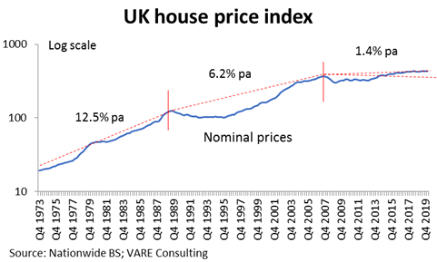

The deteriorating long-term returns from residential property

The
chart
has
been
divided
into
three
distinct
periods,
defined
by
inflection
points
at
price
peaks
and
subsequent
slumps
in
prices.
Why
these
inflection
points,
which
really
only
represent
cyclical
movements,
should
also
represent
secular
changes
is
the
subject
of
a
further
note.
Nevertheless,
the
differences
are
stark,
with
the
most
recent
period
offering
a
very
poor
rate
of
capital
growth
from
the
last
peak
in
2007
to
the
present
day.
The
sharp-eyed
amongst
the
readers
will
see
a
second
dashed
line
on
the
chart
for
the
current
period.
The
lower
one
represents
a
modest
fall
from
the
pricing
peak
and
reflects
a
general
expectation
as
a
result
of
the
2020
recession.
This
is
there
primarily
to
suggest
that
the
upper
dashed
line
represents
a
peak-to-peak
measurement,
comparable to the other measured periods.
Beneficiaries and losers
For sociologists and aspiring owner-occupiers, lower house price growth might be good news. Owning residential assets – the main assets of the population – is no longer producing the growth in wealth for the most affluent. Over time, this will tend to make housing more affordable and to equalise asset wealth across the population. This is being reinforced by the current vogue of a continuing process of property improvement through replacement of parts of the property that are only partially depreciated (eg new kitchen units) for the purposes of style or change for the sake of change. Such activity effectively reduces depreciation of the housing stock but benefits the buyers. For pure investors (non-owner-occupiers) and those owner-occupiers whose main objective is capital appreciation, this might represent a reason to generally avoid the market and to invest their capital elsewhere, such as in equities. Although there are other factors, such as changes in taxation, which have deterred private investors, the lack of capital appreciation is driving a number of private investors from the market as the total returns can often fail to even match the cost of capital. More constructively, it suggests a need to be much more tactical than being a long-term investor. Again, this will be the subject of a further note. For house-builders, a lack of growth in house prices, given that their input costs (labour and building materials) will grow with inflation, places their profits margins under pressure. For them, and contrary to general perceptions, low growth in house prices signifies a lack of demand. One safety valve is the cost of raw land, the price of which will vary depending on demand, as the supply is largely fixed. However, house builders will largely be competing with the existing land uses or alternative uses for the land, and this can limit the responsiveness of land prices to housing demand. Finally, for existing owner-occupiers, most of whom – according to the research – could not afford to buy the house that they occupy, this suggests that they may need to re-think their predilection to own a property greater than their needs and to continuously modernise their homes. The latter activity accelerates the rate of depreciation and produces a poor return on the marginal capital employed which, unless an immediate sale is being contemplated, may be negative. Of course, this is also true of most purchases of chattels, particularly those involving technology, but chattels are not typically purchased to effect a financial improvement in the well-being of the owner. All of the above assumes that the low growth in house prices over the latest period will continue or fall further. I will deal with this in a separate article.
While
UK
commercial
property
ownership
is
dominated
by
investors,
the
residential
market
is
dominated
by
owner-occupiers.
That
indicates
the
need
for
a
different
basis
for
comparing
the
markets:
nvestors
see
total
returns
whereas
owner-occupiers
see
the
market
in
terms
of
capital
pricing
(and
compare,
as
a
separate
calculation,
the
difference
in
mortgage
repayments
–
which
normally
includes
capital
repayment
–
and
the
alternative
of
rent).
In
the
UK,
the
concept
of
implied
rent
as
an
economic
characteristic
of
owner-
occupation
has
been
almost
completely
removed
from
the
population’s
consciousness
with
the
withering
and eventual abolition of UK Schedule A taxation.
Certainly,
there
are
other
players
in
the
residential
market
–
investors
who
rent
out
housing
and
providers
of
social
housing
are
the
two
other
main
owning
groups
–
but
these
are
substantially
price-takers,
with
prices
of
both
land
and
buildings
being
determined
by
the
owner-occupiers
(or
their
agents,
such
as
the
mainstream
house-builders)
who
would
tend
to
out-bid
the
other
groups
in
a
competitive
environment.
This
raises
the
prices
and
lowers
the
returns
to
pure
financially-driven
investors
and
is
the
main
reason
why
institutions,
in
particular,
have
found
it
very
difficult
to
participate
in
this
sector
of
the
property
asset
class
as
opposed
to
commercial
property
where
they
are
the
dominant
holders.
For
owner
occupiers,
owning
is
not
just
about
utility
–
or
having
somewhere
to
live
–
but
also
about
status
and
security.
Investors
seek
to
maximise
net
returns,
whereas
occupiers
seek
to
maximise
social
and
other
benefits,
while
also
seeking
to
at least keep pace with market prices so that they can relocate without losing ‘value’.
The
desire
for
more
and
better
housing,
as
well
as
competition
from
other
land
uses
and
the
restrictions
on
supply
imposed
by
planning
controls,
has
meant
that
house
prices
have
tended
to
rise
over
the
long-term.
There
is
no
law
of
economics
that
says
that
this
has
to
happen,
but
the
tendency
reflects
the
increasing
affluency
of
the
population,
in
particularly
–
in
a
circular
argument
–
the
increasing
affluency
of
the
wealthier
parts
of
the
population.
As
people
become
more
affluent,
they
tend
to
spend
more
of
their
discretionary spending on housing and services.
For
owner-occupier
buyers,
as
opposed
to
owner-occupiers
generally,
the
limiting
factor
on
their
buying
power
is
the
availability
of
finance:
the
equity
(or,
colloquially,
the
deposit)
and
debt
(or
mortgage).
Both
are
largely
dependent
on
household
earnings
and
growth
in
earnings,
although
the
provision
of
mortgages
is,
in
part,
dependent
on
lending
policies
of
banks/building
societies
and
the
control
by
regulators
(now
mainly the Bank of England).
The
Bank
of
England
has
been
particularly
active
in
recent
years
in
attempting
to
avoid
the
risk
of
market
‘over-heating’
by
matching
the
availability
of
mortgage
offers
with
the
long-term
ability
to
service
the
loans.
Even
so,
it
has
probably
only
been
partially
responsible
for
the
slowing
rate
of
house
prices
growth
in the last 50 years, which is shown in the chart below.





Ltd

























































































































































































































































